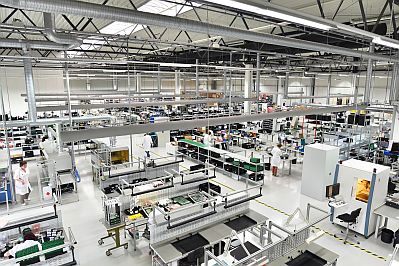How to Make AI Smart Enough for Metalworking
Metalworking, like many other areas of the manufacturing sector, is under extreme pressure to increase efficiency and productivity while reducing costs in order to innovate and compete globally. Artificial intelligence (AI) has a lot of potential to achieve these goals by automating areas like predictive maintenance, process optimization, anomaly detection and workplace safety. However, as Dynam.AI's Diana Shapiro and Dimitry Fisher write, many industry leaders have learned that not all AI is created equal.
In highly unpredictable, constantly changing environments, traditional machine learning (ML) methods often fail to produce AI solutions that do what they're supposed to do.

Context augmentation is key to developing AI that works in real-world production and factory settings.
If you're going to invest the time and money in developing AI that will prevent equipment damage, send alerts if workers aren't wearing proper personal protective equipment (PPE) or ensure that a certain part is machined or cut to exact dimensions, that AI solution needs to "understand" your specific environment, situation, or task. But how do you know the ML method you or your developers are using to develop your AI is smart enough to do that?
The key words: context augmentation.
Traditional AI processes information quickly, but it's not necessarily a critical thinker. It does not innately infer or predict things that even a human toddler would (i.e. if you let go of something, it will fall on the floor). Therefore, it is often unable to apply those factors when interpreting the data it receives.
Context augmentation, however, is a ML method that introduces scientific "first principles" like physics, macroeconomics and human behavior to data, so that your developers can create better AI. This means, for example, that your automated sensors won't mistake a shadow or PPE item for a person -- but they will be able to use vibrations to know the difference between a cart rolling and a human worker walking, and alert or warn the human who is potentially too close to a dangerous piece of equipment.

The right AI programs can automate processes and provide data that improves critical decision-making for industrial sector businesses.
Here's why AI doesn't always live up to its potential in the metalworking industry, and how context augmentation in AI is the key to making it smart enough for this space.
The Problem
By now, almost every industry leader knows that automation using AI is the future. Manufacturing businesses, including those in metallurgy and metalworking, own 50% of all the motion, image, heat, vibration and other sensors in workplace environments worldwide. This number is forecasted to grow by at least 9% year-over-year through 2026. Even in the steel industry, which is often using equipment or technologies that are nearly a hundred years old, companies are now starting to depend on automated sensors to power everything from hot metal detectors to laser scanners, and measure things like positioning, pressure, roll force, vibration, moisture, radiation, conductivity and oxygen level.
However, metalworking is an extremely nuanced industry, with niche and highly specific needs and equipment that have to operate in extreme temperatures and fluctuating environments. Workplace safety, efficiency, production line monitoring, anomaly detection, predictive maintenance: all of these have to be addressed very differently depending on the process in a particular production space, the material being worked with, and many other variables.

Working with the right developer that understands context augmentation can help speed up the implementation of AI in metalworking businesses by up to 65 percent.
Most AI developers that industry leaders might work with, meanwhile, rely on traditional ML methods to create one-size-fits-all solutions. Worse yet, it's hard to know how traditional ML reaches the conclusions it does, as it ignores valuable human knowledge and instead uses data quirks and artifacts that are oftentimes meaningless or irrelevant. Most concerningly, traditional ML requires volumes of data to even begin to work properly in every specific case, and not every company is able to provide that.
The Solution
Physical context is extremely important for AI that makes sense of sensor data. Context augmentation provides information that is not available, or not salient, in the sensor data proper, but is required for appropriate interpretation of the sensor data.
As in the parable of the blind men and the elephant, automated sensors only provide partial data, which is not easily reconcilable or interpretable. It doesn't give the full picture. Context augmentation provides the knowledge about a physical system, allowing the sensor data interpretation by an AI, akin to how it is interpreted by a human. In other words, context augmentation gives your solution the context needed to understand all of the parts of the elephant that exist beyond what the sensors can immediately detect.
Intelligent decision-making is involved in most AI applications in metalworking. Safety, efficiency, predictive maintenance, anomaly detection, quality assurance, management of supply inventory and resources, etc. all require AI to make decisions based not just on sensor data, but also on the specific context that data is gathered in.
In a metalworking environment, your AI tools need to be able to look at any data you give them and say more than just "this is an anomaly." They need to be able to say "this sensor reading is an anomaly likely caused by excessive heating due to friction and could indicate a problem in X system."
Dynam.AI has worked with a number of industrial clients in this space using CAML, a context augmentation tool. For example: with one major manufacturing company, the company is able to design, implement and train a solution comprising multiple models that were able to factor in a number of complex variables, in the presence of vibrations and dust, to enable real-time detection and alerts indicating if workers were following proper safety protocols when operating equipment.
Conclusion
Manufacturers in America need to automate and need to understand AI. Meanwhile, AI has a great potential to transform the metalworking industry, but many leaders have found that traditional machine learning methods do not give them the results they need.
Metalworking is a nuanced space that requires extremely intelligent, specific AI to make sense of sensor data and offer actionable decision intelligence. Working with a development partner that can properly use context augmentation to develop AI solutions is the key to revolutionizing metalworking, making your business more competitive and building new revenue streams. Context augmentation is what makes AI smart enough to adapt to highly complex, specialized environments, providing a good ROI for your metalworking business.
Want more information? Click below.
Diana Shapiro is CEO of Dynam.AI, an artificial intelligence (AI) software development firm automating critical decision-making for the industrial sector. Dimitry Fisher is the Chief Scientific Officer of Dynam.AI and the inventor of the company's patent-pending Context Augmented Machine Learning (CAML) method.
Rate this article
View our terms of use and privacy policy ::m::